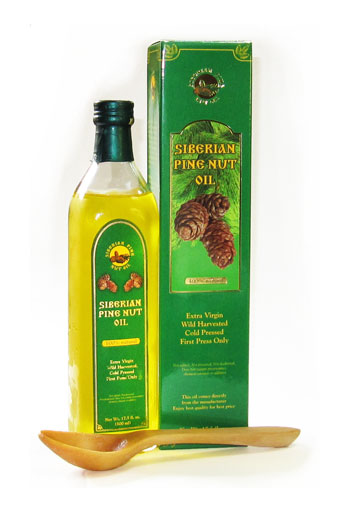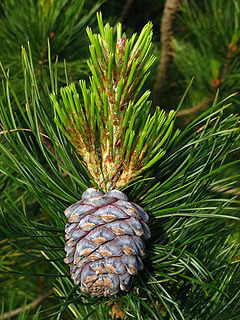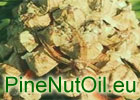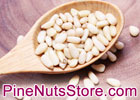PROPHYLACTIC NUTRITION:
EFFECTIVENESS OF USING SIBERIN PINE NUT OIL IN THE COMPREHENSIVE TREATMENT OF PATIENTS WITH ARTERIAL HYPERTENSION
Yu. V. Bakhtin, V. V. Budaeva, A. L. Vereshchagin, E. Yu. Egorova, E. E. Zhukova, A. S. Saratikov
Biysk Institute of Technology, I. I. Polzunov Altai State Technical University, Biysk
 In patients with arterial hypertension who are receiving basic hypertension treatment, the consumption of a 17.5 g daily dose of Siberian pine nut oil demonstrated a cholesterol lowering effect, was accompanied by the normalization of the lipid spectrum of the blood and systolic pressure, and a decrease in excess body mass.
In patients with arterial hypertension who are receiving basic hypertension treatment, the consumption of a 17.5 g daily dose of Siberian pine nut oil demonstrated a cholesterol lowering effect, was accompanied by the normalization of the lipid spectrum of the blood and systolic pressure, and a decrease in excess body mass.
The prime objective in treating a patient with arterial hypertension is to lower his elevated blood pressure and thereby reduce the risk of the onset of cardiovascular complications that occur, as is well known, on the background of an elevated level of cholesterol in the blood and general obesity.
To achieve this indicated objective, in Altai Krai over the past four years we have drawn on the experience from the School for Arterial Hypertension Patients [4]. Special attention in the programme of this school is paid to the correction of disruptions in lipid metabolism, first and foremost, hypercholesterolemia, obesity, and also the regular observance of the principles of sound nutrition. In the process, a lowering of the total calorie value of the food (to 2000 kcal/day) is actively promoted, as is the obligatory daily consumption of fresh vegetables and fruits, and the replacement of animal fats with fats from fish products and vegetable oils, which are rich in essential polyunsaturated fatty acids from the omega-3 and omega-6 families. Of the vegetable oils, sunflower, olive, linseed oil are more often used, Siberian pine nut oil is used more rarely.
All the oils listed, with the exception of Siberian pine nut oil, as is well known, are rich in alpha-linolenic acid. Characteristic for Siberian pine nut oil is the presence of octadecatrienoic acids, whose composition is dominated by the 5,9,12 isomer; the location of the first bond (5) distinguishes it from gamma-linolenic acid. The presence of precisely this isomer in Siberian pine nut oil has been determined by both foreign [7, 8] and domestic authors [5], moreover in the latter paper it was determined using the chromato-spectrometric method. Siberian pine nut oil, although not included in the list of industrial vegetable oils (its production in Russia in 2003 came to only 50 tons on the background of 1500 thousand tons of the total vegetable oil produced in the country), is eagerly used in food by the population of Gorny Altai and Khakasin [4], which satisfies the special local nutritional peculiarities of the patients [3].
The goal of this study is to determined the level of effectiveness of using of Siberian pine nut oil in the comprehensive therapy of arterial hypertension.
Material and methods
In our study we used Siberian pine nut oil bearing the Siberian Pine Nut Oil trademark, made according to the original technology of cold-pressing. It is a transparent liquid with the colour of golden straw, a delicate nutty taste, and a characteristic aroma. The oil is obtained by the cold pressing of selected shelled kernels. The Siberian pine nut oil obtained in this manner is packed only in a glass container. The produced oil is unrefined and therefore the most valuable, since it preserves the natural fatty-acid composition of the kernel of the pine nut, tocopherols, sterols, phosphatides, and other native biologically active components, which ensure an extended shelf life of the product. The physiochemical features of the oil are presented in Table 1.
Table 1. Physicochemical indicators of the
Siberian pine nut oil used
| Indicator | Standard |
Results of the analysis |
Density at 20˚C, g/cm3 |
0.917-0.930 |
0.922 |
Fraction of the total mass of moisture, % (no more than) |
0.50 |
0.02 |
Fraction of the total mass of non-fat ingredients (residue by mass), % (no more than) |
1.5 |
absent |
Fraction of the total mass of tocopherols, mg % (no less than) |
50 |
52 |
Indicators of oxidation damage: |
|
|
acid number, mg CON/g (no more than) |
4.00 |
0.15-1.20 |
peroxide number, mmol (1/2O)/kg (no more than) |
10.0 |
0.8-6.0 |
The safety coefficients of Siberian pine nut oil meet the requirements of Public Health Regulations and Standards 2.3.2.1078-01, which attests to the ecological purity of the pine nut purchased for processing. The amino-acid composition of the oil (Table 2) corresponds to the standard norms for Siberian pine nut oil [2].
Table 2. Fatty acid components in Siberian pine nut oil
| Fatty acid | Designation of the fatty acid |
Fraction of the total mass of the fatty acid, % |
Tetradecanoic (myristic) |
C 14:0 |
0.04 |
Hexadecanoic (palmitic) |
C 16:0 |
4.50 |
9-hexadecenoic (palmitoleic) |
C 16:1 |
0.30 |
Octadecanoic (stearic) |
C 18:0 |
3.10 |
9-octadecanoic (oleic) |
C 18:1 |
22.30 |
Unidentified |
|
1.60 |
9,12-octadecadienoic (linoleic; W-6) |
C 18:2 |
46.10 |
5,9,12-octadecatrienoic (gamma-linolenic; W-6) |
C 18:3 |
19.60 |
9,12,15-octadecatrienoic (alpha-linolenic; W-3) |
C 18:3 |
0.30 |
Unidentified |
|
0.19 |
A distinguishing feature of the Siberian pine nut oil used according to Official Standard 30623-98 is the presence of gamma-linolenic acid with a fraction of the total mass not less than 18%.
 In accordance with the standards for physiological requirements in food substances and energy, and the recommendations of the Food and Agricultural Organization of the United Nations and the World Health Organization, the rated daily requirement in fats, including polyunsaturated fatty acids, comes to 11 g [6]. The pine nut oil we used is a valuable source of polyunsaturated fatty acids, moreover the content of the total omega-3 and omega-6 acids is 60 to 66%. To meet the daily requirement in Siberian pine nut oil as a source of essential fatty acids, it was recommended that the participants in the study consume 17.5 g or 20 ml (two tablespoons) of oil per day.
In accordance with the standards for physiological requirements in food substances and energy, and the recommendations of the Food and Agricultural Organization of the United Nations and the World Health Organization, the rated daily requirement in fats, including polyunsaturated fatty acids, comes to 11 g [6]. The pine nut oil we used is a valuable source of polyunsaturated fatty acids, moreover the content of the total omega-3 and omega-6 acids is 60 to 66%. To meet the daily requirement in Siberian pine nut oil as a source of essential fatty acids, it was recommended that the participants in the study consume 17.5 g or 20 ml (two tablespoons) of oil per day.
The study was conducted with the participation of two groups of patient-participants in the "School for Arterial Hypertension Patients" at Municipal Hospital No. 4 at Biysk. The basic group (p = 12) and control group (p = 12) did not differ in the age of the subjects or the expression of arterial hypertension (I-II stage), the blood content of total cholesterol, and also the body mass index. Patients in both groups received basic hypertension therapy and followed the recommendations for their diet. Patients of the first, basic group, in distinction to the second, control group, over the course of three months took a daily dose of 17.5 g of Siberian pine nut oil (as desired: on an empty stomach, one tablespoon twice a day, or during the consumption of meals, as part of vegetable salads).
In the initial period, the lipid spectrum of the blood of all subjects was studied to determine the content of total cholesterol, cholesterol with low density lipoproteins (LDL) and high density lipoproteins (HDL), triglycerides, and also the level of atherogenesis, the body mass index, and blood pressure. The indicators of lipid metabolism were determined for a second time in the control group after three months, in the basic group after one and three months of observation, and the body mass index and blood pressure in both groups after three months. An analysis of the lipid spectrum of the blood was carried out according to the standardized method of determining total cholesterol, HDL cholesterol, and LDL cholesterol; the body mass index and arterial pressure were determined using standard methods.
The results obtained were processed according to the Student's t-distribution with a determination of the arithmetic mean (M) and its standard error (m). An evaluation of the normality of the distribution in the samples was conducted according to the criterion of Kolmogorov-Smirnov. The Statistics 5.0 program for Windows was used.
Results and discussion
In patients of the first group, after one month, a substantial lowering of the level of LDL cholesterol, triglycerides, and the atherogenic index was detected (Table 3), after three months the lipid reducing effect of Siberian pine nut oil under Siberian Pine Nut Oil trade mark was even more pronounced. The level of HDL cholesterol in patients who received Siberian pine nut oil under Siberian Pine Nut Oil trade mark reliably increased after one month by 35%, and after three months, by 29% from the initial point. As a result, indicators, such as the level of total cholesterol, HDL cholesterol and triglycerides reached the target value, while the level of LDL cholesterol was close to it. The atherogenic index, although decreased by 40%, did not reach the target value (2.6), but came to 2.9.
In the control group after three months only a tendency to the lowering of the level of total cholesterol (p=0.06) was observed, without substantial changes in the remaining indicators. As can be seen from Table 4, in patients of the basic group the lowering of the systolic pressure was more pronounced (by 19.5%) than in the control group (by 10.6%), in this case the diastolic pressure became lower in the groups approximately in equal measure. The lowering of the body mass index was also more pronounced in patients in the first group.
Table 3. Indicators of the lipid spectrum of the blood (in mmol/l)
in patients with arterial hypertension (M+/-m)
| Indicator | Prior to the study |
After 1 month of the study |
After three months of the study |
|||||
|
First group |
Second group |
First group |
% |
First group |
% |
Second group |
% |
Total cholesterol |
5.48+/-0.16 |
5.76+/-0.17 |
5.31+0.16 |
-3.1 |
4.86+/-0.15* |
-11.3 |
5.34 +/-0.16 |
-7.3 |
LDL cholesterol |
3.86+/-0.17 |
3.62+/-0.1 |
3.39+/-0,15' |
-12.1 |
3.05+/-0.14** |
-20.9 |
3.47+/-0.16 |
-10.1 |
HDL cholesterol |
0.79+/-0.04 |
0.91 +/-0.04 |
1.07+/-0.05** |
+35.4 |
1.02+/-0.05** |
+29.0 |
0.86+/-0.04 |
-5.5 |
Triglycerides |
2.10+/-0.25 |
2.41 +/-0.28 |
1.3+/-0.16* |
-38.1 |
1.43+/-0.17* |
-31.9 |
2.23+/-0.27 |
-7.5 |
Atherogenic index |
4.88+/-0.20 |
3.97+/-0.16 |
3.16+/-0.13** |
-35.2 |
2.9+/-0.12** |
-40.6 |
4.03+/-0.16 |
+2.0 |
Note. A - change in the indicator, expressed as a percentage; here and in Table 4: * - p<0.05; ** - p<0.001 compared to the original indicator.
Table 4. Dynamics of the change of the body mass index
and arterial pressure in the subjects (M+/-m)
| Indicator | First group |
Second group |
||||||
initially |
after three months |
initially |
after three months |
|||||
average |
A |
average |
A |
|||||
absolute |
% |
absolute |
% |
|||||
Body mass index, kg/m2 |
33.7+/-0.6 |
30.4+/-0.4" |
-3.3 |
9.8 |
32.3+/-0.5 |
31.0+/-0,5 |
-1.3 |
4.0 |
Systolic pressure, mm Hg |
174+/-5 |
140+3" |
-34 |
19.5 |
170+/-5 |
152+/-4* |
-18 |
10.6 |
Diastolic pressure, mm Hg |
98+/-3 |
86+/-2" |
-12 |
12.2 |
100+/-3 |
90+/-2* |
-10 |
10.0 |
The results obtained make it possible to conclude that Siberian pine nut oil under Siberian Pine Nut Oil trade mark, which has a cholesterol lowering effect, promotes the normalization of the lipid spectrum of the blood and the systolic pressure, and a reduction of excess body mass. It should also be emphasized that all patients mentioned the high taste qualities of the Siberian pine nut oil under Siberian Pine Nut Oil trade mark, its good tolerability, the absence of dyspeptic phenomena, and an increase in their ability to work during the second half of the day.
The use of high quality Siberian pine nut oil under Siberian Pine Nut Oil trade mark in the comprehensive therapy of arterial hypertension makes it possible to lower the magnitude of patients' blood pressure, the content of cholesterol in their blood, and their body mass index. Thus, Siberian pine nut oil may be used for the treatment of arterial hypertension in persons with accompanying obesity, hyperlipoidemia and hypercholesterolemia with the goal of correcting risk factors and the prevention of cardiovascular complications.
http://www.pinenutoil.org/
Used by permission.
© Copyright CedarInfo.info






